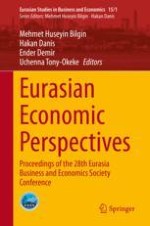2020 | Buch
Eurasian Economic Perspectives
Proceedings of the 28th Eurasia Business and Economics Society Conference
herausgegeben von: Prof. Dr. Mehmet Huseyin Bilgin, Hakan Danis, Assist. Prof. Ender Demir, Assist. Prof. Uchenna Tony-Okeke
Verlag: Springer International Publishing
Buchreihe : Eurasian Studies in Business and Economics
